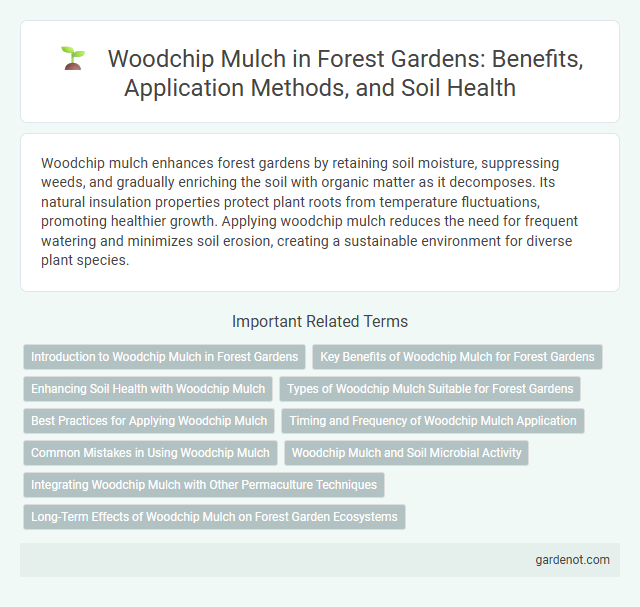Woodchip mulch enhances forest gardens by retaining soil moisture, suppressing weeds, and gradually enriching the soil with organic matter as it decomposes. Its natural insulation properties protect plant roots from temperature fluctuations, promoting healthier growth. Applying woodchip mulch reduces the need for frequent watering and minimizes soil erosion, creating a sustainable environment for diverse plant species.
Introduction to Woodchip Mulch in Forest Gardens
Woodchip mulch in forest gardens enhances soil moisture retention, suppresses weed growth, and slowly decomposes to enrich soil organic matter, promoting healthy plant development. This biodegradable layer supports beneficial microbial activity and nutrient cycling, essential for sustainable forest garden ecosystems. Applying a thick layer of woodchips around trees and shrubs mimics natural forest floors, improving soil structure and reducing erosion.
Key Benefits of Woodchip Mulch for Forest Gardens
Woodchip mulch in forest gardens conserves soil moisture by reducing evaporation, promoting healthier plant growth and resilience during dry periods. It improves soil fertility through gradual decomposition, releasing essential nutrients that support diverse plant species and enhance overall ecosystem productivity. This organic mulch also suppresses weeds and moderates soil temperature fluctuations, creating optimal growing conditions for trees, shrubs, and understory plants.
Enhancing Soil Health with Woodchip Mulch
Woodchip mulch improves soil health by increasing organic matter content, promoting microbial activity, and enhancing moisture retention in forest gardens. It reduces soil erosion, suppresses weeds, and gradually decomposes to release essential nutrients like nitrogen and phosphorus. Using woodchip mulch supports a sustainable ecosystem by fostering beneficial soil organisms and improving soil structure over time.
Types of Woodchip Mulch Suitable for Forest Gardens
Woodchip mulch in forest gardens primarily includes hardwood, softwood, and leaf mulch varieties, each supporting soil health and moisture retention differently. Hardwood mulch, derived from oak or maple, decomposes slowly, enriching soil with vital nutrients over time, while softwood mulch from pine or cedar offers rapid moisture retention but may acidify soil. Leaf mulch, composed of shredded leaves, provides a balanced nutrient release and enhances microbial activity essential for forest garden ecosystems.
Best Practices for Applying Woodchip Mulch
Apply woodchip mulch in a 2-4 inch layer to maintain soil moisture and regulate temperature in forest gardens. Avoid piling mulch directly against tree trunks to prevent rot and pest infestations. Select hardwood chips from untreated sources to ensure nutrient-rich decomposition that supports diverse plant health.
Timing and Frequency of Woodchip Mulch Application
Applying woodchip mulch in forest gardens is most effective during early spring or late fall to conserve soil moisture and suppress weeds before the growing season or winter dormancy. Reapplication should occur every 1 to 2 years, as the mulch decomposes and thins, maintaining optimal thickness of 5 to 10 cm. Monitoring soil health and moisture levels guides timely replenishment, ensuring sustained nutrient cycling and plant health.
Common Mistakes in Using Woodchip Mulch
Applying woodchip mulch too thickly can suffocate plant roots by limiting oxygen flow and promoting excessive moisture retention, which leads to root rot. Using fresh, untreated woodchips may introduce toxins like allelopathic compounds that inhibit seed germination and plant growth. Failing to maintain a mulch barrier away from tree trunks invites pests and disease, causing bark decay and structural damage.
Woodchip Mulch and Soil Microbial Activity
Woodchip mulch enhances soil microbial activity by providing a continuous supply of organic matter that serves as food for soil microorganisms, boosting their diversity and population. This increased microbial activity improves nutrient cycling, soil structure, and moisture retention in forest gardens. As a result, woodchip mulch promotes healthier plant growth and contributes to a more resilient and productive ecosystem.
Integrating Woodchip Mulch with Other Permaculture Techniques
Woodchip mulch enhances soil moisture retention and suppresses weeds, creating an optimal environment for companion planting and polyculture systems in forest gardens. When combined with sheet mulching and nitrogen-fixing plantings, woodchips accelerate nutrient cycling and improve soil structure. Integrating woodchip mulch with swales and keyline design further boosts water infiltration and erosion control, promoting a resilient and sustainable permaculture ecosystem.
Long-Term Effects of Woodchip Mulch on Forest Garden Ecosystems
Woodchip mulch significantly improves soil health in forest garden ecosystems by enhancing moisture retention, suppressing weeds, and promoting beneficial microbial activity. Over time, the decomposition of woodchips enriches the soil with organic matter, boosting nutrient cycling and supporting diverse plant growth. Consistent use of woodchip mulch fosters a resilient, self-sustaining forest garden environment by stabilizing soil structure and increasing biodiversity.
Woodchip mulch Infographic

 gardenot.com
gardenot.com